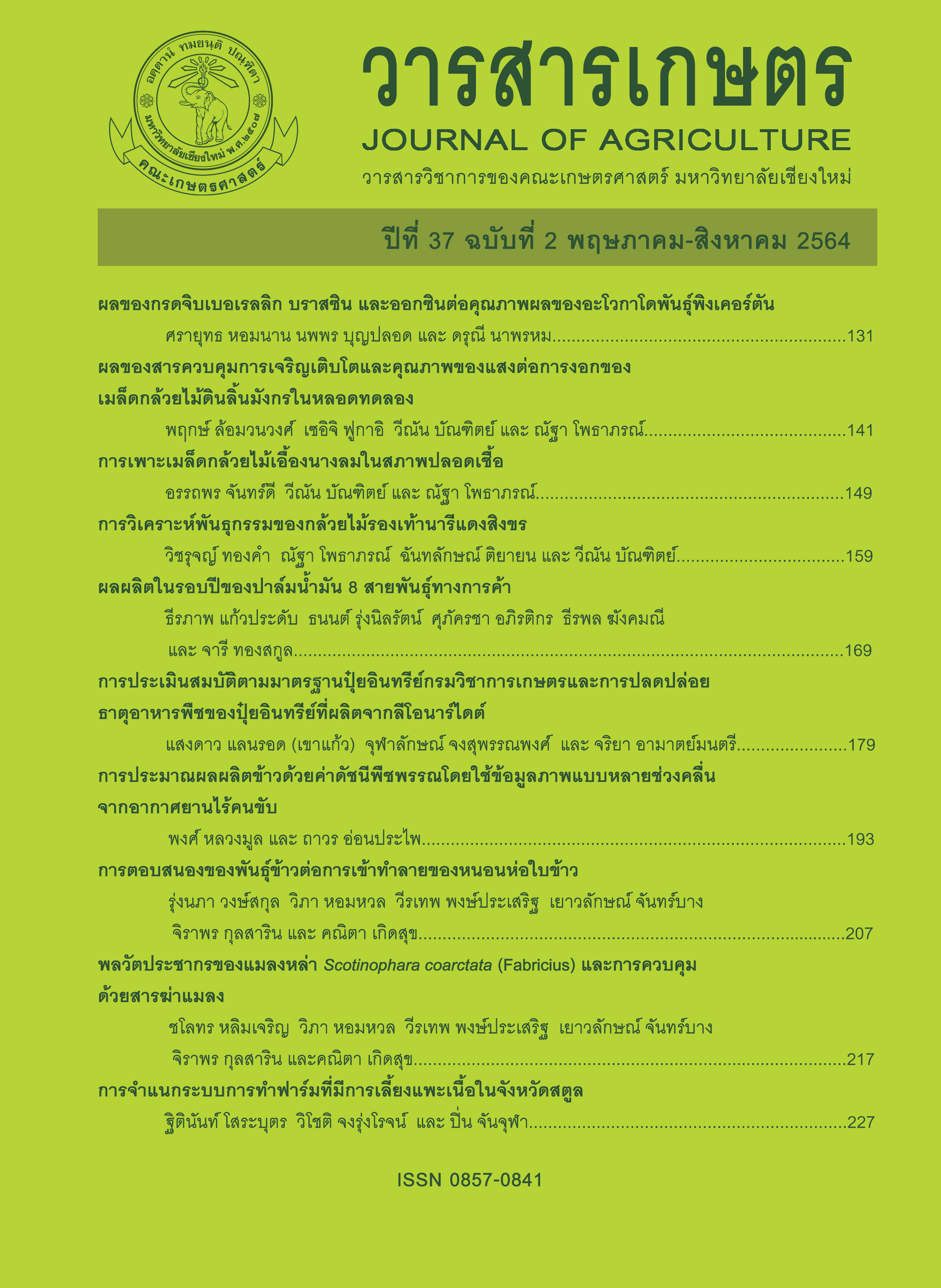ผลของกรดจิบเบอเรลลิก บราสซิน และออกซินต่อคุณภาพผลของอะโวกาโดพันธุ์พิงเคอร์ตัน
Main Article Content
บทคัดย่อ
การศึกษาผลของสารควบคุมการเจริญเติบโตของพืชต่อการพัฒนาคุณภาพผลอะโวกาโดพันธุ์พิงเคอร์ตัน ทดลอง ณ ศูนย์พัฒนาโครงการหลวงทุ่งเริง อำเภอหางดง จังหวัดเชียงใหม่ โดยวางแผนการทดลองแบบสุ่มสมบูรณ์ (CRD) 3 ซ้ำ ประกอบด้วย 7 กรรมวิธี ได้แก่ 1) กรรมวิธีควบคุม (พ่นน้ำเปล่า) 2) กรดจิบเบอเรลลิก (GA3) 25 มิลลิกรัมต่อลิตร 3) กรดจิบเบอเรลลิก 50 มิลลิกรัมต่อลิตร 4) บราสซิน (BR) 0.5 มิลลิกรัมต่อลิตร 5) บราสซิน 1 มิลลิกรัมต่อลิตร 6) Maxim® (3, 5, 6 - TPA) 15 มิลลิกรัมต่อลิตร และ 7) Maxim® 30 มิลลิกรัมต่อลิตร ในทุกกรรมวิธีทำการพ่นสาร 2 ครั้ง ที่ส่วนของผล พ่นครั้งที่ 1 ในระยะติดผลขนาดความกว้างผลประมาณ 50 มิลลิเมตร ความยาวผลประมาณ 80 มิลลิเมตร และพ่นครั้งที่ 2 ก่อนเก็บผลผลิต 1 เดือน ผลการศึกษา พบว่า การพ่น GA3 25 มิลลิกรัมต่อลิตร มีการเพิ่มขึ้นของความกว้างผลในเดือนกันยายน 23.99 % ซึ่งมากกว่า 19.67 % ของกรรมวิธีควบคุมอย่างมีนัยสำคัญ ในขณะที่การเพิ่มขึ้นของความยาวผลไม่มีความแตกต่างกันในทุกกรรมวิธี การพ่น BR 0.5 มิลลิกรัมต่อลิตร และ Maxim® 15 มิลลิกรัมต่อลิตร ทำให้มีน้ำหนักผลในระยะเก็บเกี่ยวมากกว่าผลในกรรมวิธีควบคุมอย่างมีนัยสำคัญ การพ่น Maxim® ทั้งสองความเข้มข้นมีผลให้ความหนาเปลือกสูง การพ่น BR 0.5 มิลลิกรัมต่อลิตร และ GA3 50 มิลลิกรัมต่อลิตร ให้ปริมาณกรดไขมันรวมเพิ่มขึ้นเมื่อเทียบกับกรรมวิธีควบคุมนอกจากนี้ กรรมวิธีที่พ่น Maxim® 15 มิลลิกรัมต่อลิตร มีเปอร์เซ็นต์กรด palmitoleic และกรด linoleic สูงที่สุด การพ่น PGRs ทุกกรรมวิธีโดยเฉพาะ GA3 50 มิลลิกรัมต่อลิตร ทำให้กรดไขมัน oleic ซึ่งเป็นกรดไขมันไม่อิ่มตัวเพิ่มขึ้นมากกว่าทุกกรรมวิธีอย่างมีนัยสำคัญ
Article Details
เอกสารอ้างอิง
Abdelgadir, H.A., A.K. Jager, S.D. Johnson and J. Van Staden. 2010. Influence of plant growth regulators on flowering, fruiting, seed oil content, and oil quality of Jatropha curcas. South African Journal of Botany 76(3): 440-446.
Agusti, M., V. Almela, I. Andreu, M. Juan and L. Zacarias. 1999. Synthetic auxin 3, 5, 6-TPA promotes fruit development and climacteric in Prunus persica L. Batsch. The Journal of Horticultural Science and Biotechnology 74(5): 556-560.
Binenbaum, J., R. Weinstain and E. Shani. 2018. Gibberellin localization and transport in plants. Trends in Plant Science 23(5): 410-421.
Chang, J.C. and T.S. Lin. 2006. GA3 increases fruit weight in ‘Yu Her Pau’ litchi. Scientia Horticulturae 108(4): 442-443.
Friedrichsen, D. and J. Chory. 2001. Steroid signaling in plants: from the cell surface to the nucleus. Bioessays 23(11): 1028-1036.
Hurtado-Fernández, E., T. Pacchiarotta, O.A. Mayboroda, A. Fernández-Gutiérrez and A. Carrasco-Pancorbo. 2015. Metabolomic analysis of avocado fruits by GC-APCI-TOF MS: effects of ripening degrees and fruit varieties. Analytical and Bioanalytical Chemistry 407: 547-555.
Iqbal, N., R. Nazar, M.I.R. Khan, A. Masood and N.A. Khan. 2011. Role of gibberellins in regulation of source-sink relations under optimal and limiting environmental conditions. Current Science 100(7): 998-1007.
Jarassamrit, N. 1994. Plant Hormones and Plant Growth Regulators. Sahamit Printing, Bangkok. 128 p. (in Thai)
Klinhom, J., J. Phunturuksa and N. Utama-Ang. 2005. Chemical compositions and physical properties of avocado mesocarp cultivated in Chiang Mai. Journal of Agriculture 21(2): 117-125. (in Thai)
Luque de Castro, M.L. and F. Priego-Capote. 2010. Soxhlet extraction: Past and present panacea. Journal of Chromatography A 1217(16): 2383-2389.
Magwaza, L.S. and S.Z. Tesfay. 2015. A review of destructive and non-destructive methods for determining avocado fruit maturity. Food and Bioprocess Technology 8(10): 1995-2011.
Nilnond, S., R. Yuwansiri, C. Sukumalanandana and P. Kermanee. 1996. Effects of gibberellic acid on seed and berry development in ‘White Malaga’ grape at Doi Inthanon, Chiang Mai province. Kasetsart Journal (Natural Science) 30(2): 157-162. (in Thai)
Pramanik, K., S.P. Das, L.K. Acharya and D. Jayapuria. 2017. Role of gibberellic acid on growth, yield and quality of tomato: A review. International Journal of Chemical Studies 5(6): 826-830.
Rademacher, W. 2015. Plant growth regulators: backgrounds and uses in plant production. Journal of Plant Growth Regulation 34(4): 845-872.
Reig, C., C. Mesejo, A. Martínez-Fuentes and M. Agustí. 2016. Synthetic auxin 3, 5, 6-TPA increases fruit size of loquat (Eriobotrya japonica Lindl.) by reducing cell turgor pressure. Scientia Horticulturae 210: 213-219.
Roghabadi, M.A. and Z. Pakkish. 2014. Role of brassinosteroid on yield, fruit quality and postharvest storage of ‘Tak Danehe Mashhad’ sweet cherry (Prunus avium L.). Agricultural Communications 2(4): 49-56.
Royal Project Foundation and Highland Research and Development Institute. n.d. Avocado. Chiang Mai. 39 p. (in Thai)
Sippel, A.D., W. Conradie and N.J.F. Claassens. 1992. Growth rates of Pinkerton avocado fruit. South African Avocado Growers' Association Yearbook 15: 72-74.
Stern, R.A., D. Stern, M. Harpaz and S. Gazit. 2000. Applications of 2, 4, 5-TP, 3, 5, 6-TPA, and combinations thereof increase lychee fruit size and yield. HortScience 35(4): 661-664.
Thapliyal, V.S., P.N. Rai and L. Bora. 2016. Influence of pre-harvest application of gibberellin and brassinosteroid on fruit growth and quality characteristics of pear (Pyrus pyrifolia (Burm.) Nakai) cv. Gola. Journal of Applied and Natural Science 8(4): 2305-2310.
Villa-Rodriguez, J.A., F.J. Molina-Corral, J.F. Ayala-Zavala, G. I. Olivas and G. A. Gonzalez-Aguilar. 2011. Effect of maturity stage on the content of fatty acids and antioxidant activity of ‘Hass’ avocado. Food Research International 44(5): 1231-1237.
Wei, Z. and J. Li. 2016. Brassinosteroids regulate root growth, development, and symbiosis. Molecular Plant 9(1): 86-100.


